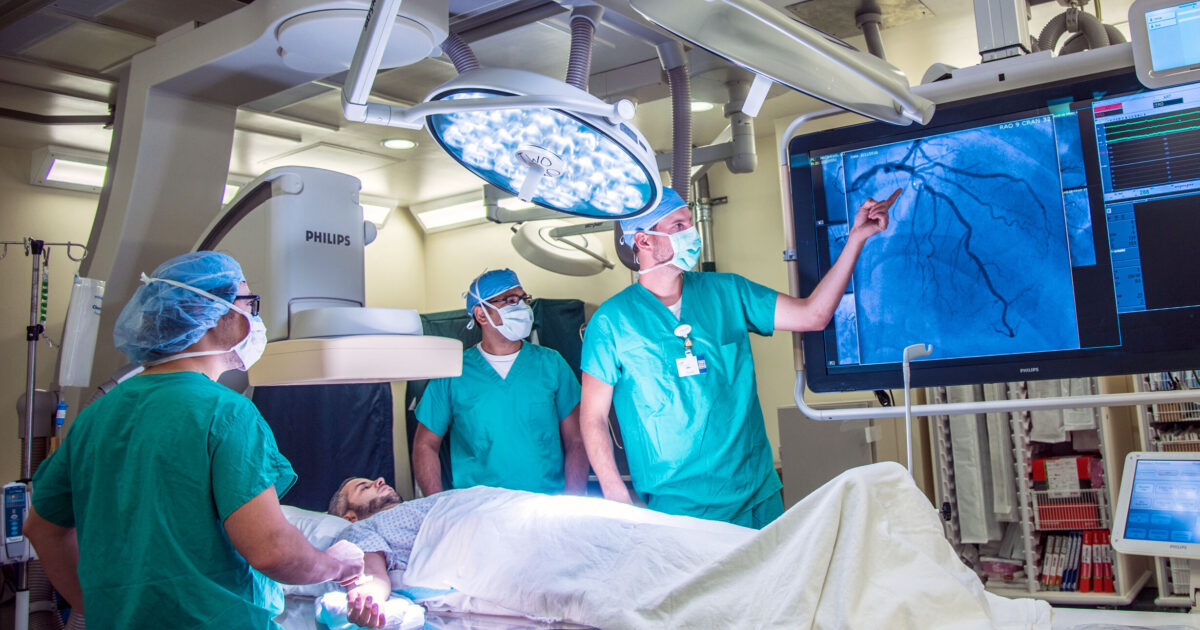Follow-up tips after your local Cardiologist visit
Follow-up tips after your local Cardiologist visit
Blog Article
Recognizing the Importance of Cardiology in Modern Healthcare Services
Cardiology plays a vital function in modern health care, especially as cardiovascular disease remains to be the leading reason for mortality worldwide. Advancements in diagnostics and therapy have actually transformed client care, enabling earlier interventions and improved end results. Moreover, the change in the direction of precautionary cardiology equips individuals to handle their wellness proactively. As innovation continues to evolve, the assimilation of cutting-edge options may further redefine cardiology's influence on public wellness, triggering a closer evaluation of emerging fads and their effects.
The Occurrence of Heart Disease and Its Effect On Public Health And Wellness
Although heart illness continues to be the leading reason of death globally, its influence prolongs much past individual patients to affect public health and wellness systems and economies. The high occurrence of cardiovascular disease positions a substantial pressure on healthcare sources, necessitating boosted funding for treatment, prevention, and rehabilitation programs. Public health efforts should deal with threat aspects such as weight problems, cigarette smoking, and inactive way of livings, which contribute considerably to the rising occurrence of heart conditions.Moreover, the economic problem related to heart illness is immense, encompassing not just straight clinical costs but additionally indirect expenses associated with shed performance and early death. Communities face difficulties in taking care of these prices, frequently causing differences in medical care accessibility and end results. As the populace ages and lifestyle-related threats remain to escalate, the necessity for effective cardiology interventions becomes critical. As a result, resolving heart condition is not just an issue of specific health and wellness yet likewise a critical public health priority.
Developments in Heart Diagnostics and Imaging Techniques
Recent developments in cardiac diagnostics and imaging strategies have actually changed the area of cardiology, improving the ability to monitor and identify heart problem. Methods such as cardiac MRI, CT angiography, and echocardiography have come to be significantly advanced, providing detailed photos of cardiac structures and functions. These modalities permit the early identification of problems like coronary artery disease, heart failing, and valvular disorders.Moreover, innovations in non-invasive diagnostics, such as wearable technology and remote monitoring tools, have actually encouraged people and health care companies. These tools promote real-time tracking of heart rhythms and various other vital signs, bring about prompt interventions. Furthermore, artificial knowledge is being integrated into imaging evaluation, enhancing accuracy and effectiveness in medical diagnosis.
Advancements in Therapy Choices for Heart Issues
Recent improvements in cardiology have actually caused substantial technologies in therapy alternatives for heart conditions. These consist of advanced medical strategies that enhance step-by-step end results and emerging medicines that use brand-new avenues for therapy. As the area evolves, these developments play an essential role in enhancing person care and outcomes.
Advanced Surgical Techniques
Advancements in medical strategies have transformed the landscape of cardiology, using new hope for clients with heart problems. Minimally intrusive treatments, such as catheter-based treatments, have actually greatly minimized recuperation times and hospital stays. Methods like robotic-assisted surgical treatment improve accuracy, enabling doctors to browse complex anatomical frameworks with better precision. Innovations in imaging modern technology assist in real-time visualization throughout procedures, boosting end results. Transcatheter aortic shutoff substitute (TAVR) exhibits an advancement in treating aortic stenosis, allowing valve replacement without open-heart surgical treatment. Furthermore, hybrid strategies that incorporate catheter-based and medical techniques provide customized remedies for numerous cardiac issues. These advanced medical strategies not just improve individual security but additionally broaden treatment choices, highlighting the vital role of technology in modern-day cardiology methods.
Arising Therapies and medicines
As the landscape of cardiology remains to advance, arising medications and treatments play a crucial duty in boosting treatment alternatives for heart conditions. Innovations such as unique anticoagulants and advanced lipid-lowering representatives have changed the administration of cardio illness, greatly lowering client morbidity and death. Furthermore, the development of gene treatments and regenerative medicine uses promising opportunities for dealing with conditions formerly deemed incurable. Medical tests are continually exposing the efficiency of these therapies, pushing the borders of conventional therapies. Moreover, the combination of electronic health innovations promotes personalized medication, enabling tailored therapy plans based on hereditary and lifestyle aspects. Jointly, these advancements emphasize the dynamic nature of cardiology, improving client results and redefining criteria of treatment in modern-day medical care.
The Duty of Preventive Cardiology in Patient Care
Preventative cardiology plays an important role in client care by focusing on the identification of threat variables that add to heart condition. Via way of living alteration approaches and very early discovery techniques, healthcare suppliers can efficiently lower the incidence of cardio occasions - Cardiology Jupiter. This proactive method not only boosts patient end results yet likewise promotes long-term wellness
Danger Element Identification
While heart diseases continue to be a leading root cause of morbidity and mortality worldwide, effective threat aspect identification serves as a cornerstone of preventative cardiology. Determining risk factors such as high blood pressure, diabetic issues, hyperlipidemia, and family background is crucial for early treatment. Health care specialists use various screening methods to review these aspects, permitting customized safety nets. Additionally, comprehending a patient's way of living options, such as smoking and physical inactivity, better notifies threat assessments. This complete evaluation enables medical professionals to create customized treatment strategies targeted at mitigating dangers. By focusing on threat element recognition, medical care systems can enhance individual end results and reduce the general problem of heart diseases, eventually adding to improved public health methods and source appropriation.
Lifestyle Modification Strategies
A wide range of research studies highlights the essential role of lifestyle adjustment methods in minimizing heart disease threat. These strategies encompass dietary changes, increased physical activity, smoking cigarettes cessation, and weight administration. By adopting a heart-healthy diet plan rich in fruits, vegetables, whole grains, and lean proteins, individuals can decrease cholesterol degrees and high blood pressure. Regular physical task strengthens the heart and enhances overall cardio health. Additionally, stopping cigarette smoking significantly lowers the risk of cardiovascular disease and enhances recovery rates for those with status quo. Weight administration additionally contributes to cardio health and check my source wellness by alleviating other risk factors such as diabetes and high blood pressure. Carrying out these way of life changes not just advertises individual well-being yet likewise acts as a keystone of precautionary cardiology in individual care.
Very Early Discovery Techniques
Way of living adjustments significantly contribute to minimizing heart disease threats, however they are most effective when coupled with early discovery methods. Preventive cardiology stresses the relevance of identifying prospective heart issues prior to they escalate right into serious problems. Techniques such as blood stress tracking, cholesterol testing, and advanced imaging modern technologies like echocardiograms play important duties in examining cardio health and wellness. Biomarkers and genetic screening also boost the precision of early discovery, enabling customized preventative methods. Regular cardiac threat evaluations equip medical care companies to interfere proactively, potentially avoiding cardiovascular disease and strokes (Cardiology). By incorporating these early detection techniques right into regular care, clients can take advantage of prompt lifestyle interventions and targeted therapies, inevitably boosting outcomes and enhancing high quality of life
Integrating Modern Technology Into Cardiology Practices
As advancements in technology continue to reshape different fields, the combination of cutting-edge devices and systems right into cardiology methods has become vital for boosting person care and results. Telemedicine platforms permit cardiologists to keep an eye on individuals from another location, boosting accessibility to care while lowering the worry on basics healthcare facilities. Wearable tools, such as smartwatches, make it possible for continual heart price surveillance, signaling both medical professionals and individuals to possible concerns in real-time. In addition, fabricated intelligence (AI) is being used to analyze huge amounts of cardiac data, assisting in early diagnosis and personalized therapy strategies. Advanced imaging methods, including 3D echocardiography, boost visualization of heart frameworks, leading to more precise interventions. Electronic have a peek at this site wellness records (EHRs) improve patient information administration, making certain that cardiologists have immediate access to essential information. With each other, these technical developments are changing cardiology, advertising aggressive administration and improved wellness results for individuals with cardiovascular problems.
The Importance of Person Education and Interaction
Client education and interaction play a pivotal function in the monitoring of cardiovascular health and wellness. By equipping clients with expertise regarding their problems, therapy choices, and way of living adjustments, doctor empower people to take an active function in their treatment. This proactive method can cause boosted adherence to prescribed medications, dietary modifications, and exercise routines, inevitably reducing the risk of complications.Engagement likewise promotes a solid patient-provider partnership, urging open communication and trust. When individuals really feel educated and entailed, they are more probable to voice concerns and ask questions, which can result in much better medical end results. In addition, instructional sources, such as workshops or electronic systems, can boost understanding and advertise self-management methods. Generally, focusing on individual education and engagement is important for enhancing cardiovascular wellness, boosting lifestyle, and lowering medical care costs related to cardio diseases.
Future Patterns in Cardiology and Their Potential Influence

Frequently Asked Questions
What Way Of Life Modifications Can Reduce Heart Disease Threat?
The present concern addresses lifestyle adjustments that can substantially minimize heart problem risk. Dr Garcia. Taking on a balanced diet regimen, participating in routine physical activity, keeping a healthy weight, managing anxiety, and preventing cigarette can significantly improve cardio health
Exactly How Can I Recognize Very Early Signs of Heart Issues?
Recognizing very early indicators of heart troubles involves surveillance signs such as upper body pain, lack of breath, fatigue, and irregular heart beat. Timely understanding of these indications can trigger required clinical assessment and treatment for better results.
What Are the Distinctions In Between Cardiologists and Cardiac Surgeons?
The distinctions in between cardiologists and cardiac specialists depend on their duties; cardiologists primarily manage and diagnose heart disease via non-invasive methods, while cardiac specialists perform operations to correct structural heart problems. Each plays an essential, distinct role.

How Frequently Should I Get My Heart Health And Wellness Checked?
The frequency of heart medical examination varies based on private danger elements. Generally, grownups ought to undergo analyses every one to 2 years, while those with status quo might need more constant evaluations as advised by medical care experts.
What Role Does Genetics Play in Heart Problem Threat?
Genetics substantially influences heart condition risk, with domestic patterns indicating inherited problems. Details genes can incline individuals to high blood pressure, cholesterol problems, and other cardio problems, highlighting the relevance of genetic testing in evaluating heart health and wellness. Heart disease stays the leading reason of death around the world, its impact expands far beyond specific patients to impact public wellness systems and economic climates. Public wellness initiatives need to resolve risk variables such as weight problems, smoking, and inactive way of livings, which add significantly to the increasing occurrence of heart conditions.Moreover, the financial burden connected with heart illness is tremendous, encompassing not only direct clinical prices yet also indirect expenses associated to shed performance and early death. Preventive cardiology plays a vital function in client treatment by concentrating on the recognition of threat variables that add to heart disease. Artificial intelligence (AI) and device knowing are improving diagnostics and individual tracking, making it possible for early discovery of heart conditions. The distinctions in between cardiologists and heart doctors exist in their duties; cardiologists mostly handle and diagnose heart conditions with non-invasive techniques, while cardiac surgeons perform medical treatments to remedy architectural heart problems.
Report this page